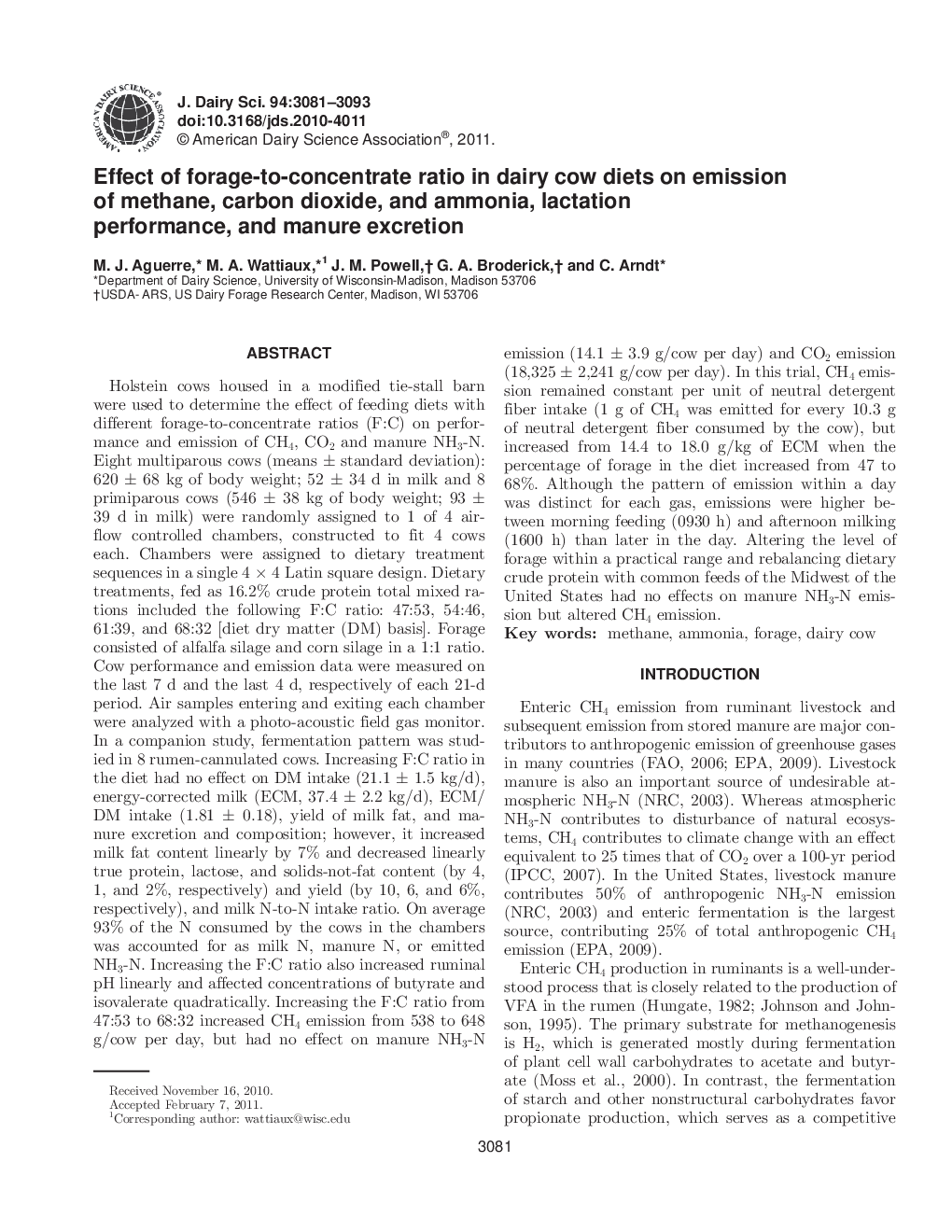| کد مقاله | کد نشریه | سال انتشار | مقاله انگلیسی | نسخه تمام متن |
|---|---|---|---|---|
| 10978577 | 1108058 | 2011 | 13 صفحه PDF | دانلود رایگان |
عنوان انگلیسی مقاله ISI
Effect of forage-to-concentrate ratio in dairy cow diets on emission of methane, carbon dioxide, and ammonia, lactation performance, and manure excretion
دانلود مقاله + سفارش ترجمه
دانلود مقاله ISI انگلیسی
رایگان برای ایرانیان
موضوعات مرتبط
علوم زیستی و بیوفناوری
علوم کشاورزی و بیولوژیک
علوم دامی و جانورشناسی
پیش نمایش صفحه اول مقاله

چکیده انگلیسی
Holstein cows housed in a modified tie-stall barn were used to determine the effect of feeding diets with different forage-to-concentrate ratios (F:C) on performance and emission of CH4, CO2 and manure NH3-N. Eight multiparous cows (means ± standard deviation): 620 ± 68 kg of body weight; 52 ± 34 d in milk and 8 primiparous cows (546 ± 38 kg of body weight; 93 ± 39 d in milk) were randomly assigned to 1 of 4 air-flow controlled chambers, constructed to fit 4 cows each. Chambers were assigned to dietary treatment sequences in a single 4 Ã 4 Latin square design. Dietary treatments, fed as 16.2% crude protein total mixed rations included the following F:C ratio: 47:53, 54:46, 61:39, and 68:32 [diet dry matter (DM) basis]. Forage consisted of alfalfa silage and corn silage in a 1:1 ratio. Cow performance and emission data were measured on the last 7 d and the last 4 d, respectively of each 21-d period. Air samples entering and exiting each chamber were analyzed with a photo-acoustic field gas monitor. In a companion study, fermentation pattern was studied in 8 rumen-cannulated cows. Increasing F:C ratio in the diet had no effect on DM intake (21.1 ± 1.5 kg/d), energy-corrected milk (ECM, 37.4 ± 2.2 kg/d), ECM/DM intake (1.81 ± 0.18), yield of milk fat, and manure excretion and composition; however, it increased milk fat content linearly by 7% and decreased linearly true protein, lactose, and solids-not-fat content (by 4, 1, and 2%, respectively) and yield (by 10, 6, and 6%, respectively), and milk N-to-N intake ratio. On average 93% of the N consumed by the cows in the chambers was accounted for as milk N, manure N, or emitted NH3-N. Increasing the F:C ratio also increased ruminal pH linearly and affected concentrations of butyrate and isovalerate quadratically. Increasing the F:C ratio from 47:53 to 68:32 increased CH4 emission from 538 to 648 g/cow per day, but had no effect on manure NH3-N emission (14.1 ± 3.9 g/cow per day) and CO2 emission (18,325 ± 2,241 g/cow per day). In this trial, CH4 emission remained constant per unit of neutral detergent fiber intake (1 g of CH4 was emitted for every 10.3 g of neutral detergent fiber consumed by the cow), but increased from 14.4 to 18.0 g/kg of ECM when the percentage of forage in the diet increased from 47 to 68%. Although the pattern of emission within a day was distinct for each gas, emissions were higher between morning feeding (0930 h) and afternoon milking (1600 h) than later in the day. Altering the level of forage within a practical range and rebalancing dietary crude protein with common feeds of the Midwest of the United States had no effects on manure NH3-N emission but altered CH4 emission.
ناشر
Database: Elsevier - ScienceDirect (ساینس دایرکت)
Journal: Journal of Dairy Science - Volume 94, Issue 6, June 2011, Pages 3081-3093
Journal: Journal of Dairy Science - Volume 94, Issue 6, June 2011, Pages 3081-3093
نویسندگان
M.J. Aguerre, M.A. Wattiaux, J.M. Powell, G.A. Broderick, C. Arndt,